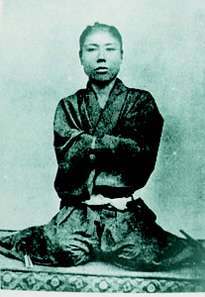Yasushi Nomura
Viscount Yasushi Nomura (野村靖, September 10, 1842 – January 24, 1909) was a Japanese bureaucrat, statesman and cabinet minister, active in Meiji period Japan
Viscount Yashushi Nomura 野村靖 | |
|---|---|
 | |
| Born | September 10, 1842 Chōshū Domain, Japan |
| Died | January 24, 1909 (aged 66) Tokyo, Japan |
| Resting place | Shōin Jinja, Tokyo, Japan |
| Nationality | Japanese |
| Occupation | Cabinet Minister |

Biography
Nomura was born as the second son of a low-ranked ashigaru samurai in Hagi, Chōshū Domain, (currently Yamaguchi Prefecture). As a youth, he studied at Yoshida Shōin's Shokansonjuku academy, where he joined the Sonnō jōi movement against the Tokugawa shogunate and the increasing foreign presence in Japan. He participated in the unsuccessful assassination attempt against the rōjū Manabe Akikatsu and in the burning of the British legation in Edo in 1862. He fought as a member of the Chōshū armies against the Tokugawa during the Second Chōshū expedition.
After the Meiji Restoration, he went to Tokyo and entered into service of the new Meiji government, and was selected as a member of the 1871 Iwakura Mission, visiting the United States, Great Britain and other European countries.[1] After his return to Japan, he was appointed governor of Kanagawa Prefecture, where he was praised for his efforts in reducing government spending.[2] He was ennobled with the kazoku peerage title of shishaku (viscount) in 1887. In 1888, he was made a member of the Privy Council and in 1891 served as Japanese ambassador to France.
Nomura was selected to become Home Minister in the cabinet of the 2nd administration of Prime Minister Itō Hirobumi in 1894. During his tenure, the three Tama districts, formerly part of Kanagawa Prefecture, were annexed to Tokyo Prefecture. Nomura returned to the cabinet as Minister of Communications in 1896 under the 2nd Matsukata administration, during which time he attempted to stem the influence of the Mitsubishi zaibatsu, which had been strongly favored by Maejima Hisoka, over control of Japanese shipping.[3]
Nomura died in 1909. His grave is at the Shōin Jinja, a Shinto shrine in Setagaya, Tokyo, near the grave of Yoshida Shōin.
References
- Keene, Donald. Emperor Of Japan: Meiji And His World, 1852–1912. Columbia University Press (2005). ISBN 0-231-12341-8
- Fredrick, Louis. Japan Encyclopedia. Harvard University Press (2005). ISBN 0674017536
- Sims, Richard. Japanese Political History Since the Meiji Renovation 1868–2000. Palgrave Macmillan. ISBN 0-312-23915-7
Notes
- Nish, Ian (2013). Britain and Japan Vol II: Biographical Portraits. Routledge. ISBN 1134246773.
- Steele, M William (2003). Alternative Narratives in Modern Japanese History. Routledge. p. 142. ISBN 1134404085.
- Wray, William D (1984). Mitsubishi and the N.Y.K., 1870–1914. Harvard University Asia Center. p. 143. ISBN 0674576659.
| Political offices | ||
|---|---|---|
| Preceded by Inoue Kaoru |
Home Minister 15 October 1894 – 3 February 1896 |
Succeeded by Yoshikawa Akimasa |
| Preceded by Shirane Senichi |
Communications Minister 26 September 1896 – 12 January 1898 |
Succeeded by Suematsu Kenchō |